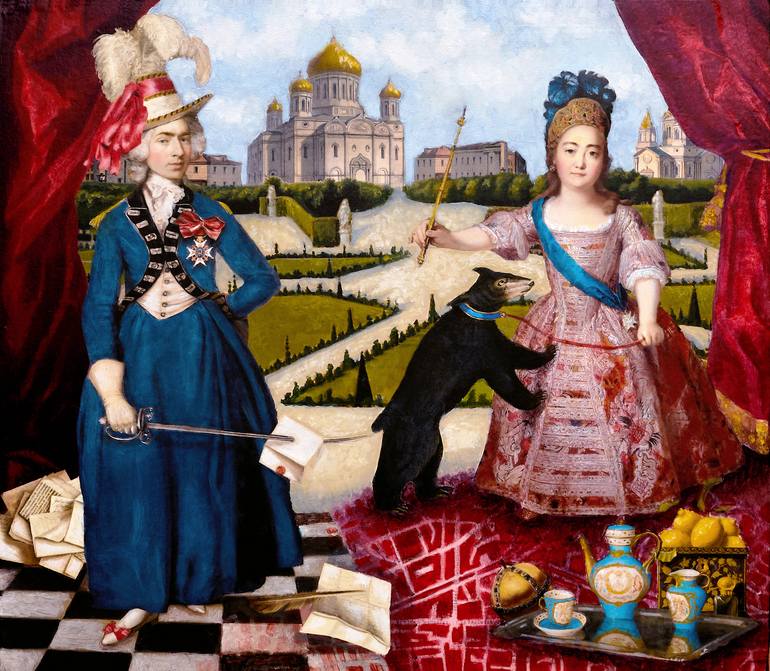


VIEW IN MY ROOM
Chevalier d’Eon 1728 - 1810 Painting
United Kingdom
Painting, Oil on Wood
Size: 13.5 W x 12 H x 1.5 D in
About The Artwork
Oil & mixed media on gesso board The Chevalier d’Eon was a French soldier, diplomat, spy and fencing demonstrator who lived as a woman from 1777. Born into a poor noble family, he excelled in school and on graduation became a civil servant. In 1756 he joined the secret network of spies called the Secret du Roi, whereupon he was sent to Russia to meet Empress Elizabeth and conspire with the pro-French faction against the Habsburg monarchy. At the time the English were attempting to deny French access to the Empress, allowing only women and children to cross the border into Russia, so d’Éon duly disguised himself as the lady Lea de Beaumont, and served as a maid of honour to the Empress. Returning to France in 1760 D’Eon became a captain of dragoons and fought in the later stages of the Seven Years’ War. In 1763 the Chevalier was sent to London to negotiate the end of the Seven Years War. Rumours that he was a woman in disguise were widely circulated and at one point there was so much speculation on whether he was male or female that people actually placed bets on the London Stock Exchange. Having initially taken the role of chargé d’affaires, the arrival of a new ambassador, the comte de Guerchy, saw d’Éon humiliated and demoted to the rank of secretary. A public feud between the two ensued, and in an effort to save his station in London, d’Éon scandalously published secret diplomatic correspondence, disavowing Guerchy and calling him unfit for his job. Guerchy sued for libel and, offering no defence, d’Éon was declared an outlaw and went into hiding. Most probably D’Éon had possession of other sensitive documents that provided protection against further actions, but he could not return to France. He continued to work as a spy, but lived in political exile in London. Following the death of Louis XV in 1774, the secret du roi was abolished. D’Éon tried to negotiate a return from exile, and it was eventually granted thus, as Madame Campan wrote in her memoirs: “This eccentric being had long solicited permission to return to France; but it was necessary to find a way of sparing the family he had offended the insult they would see in his return; he was therefore made to resume the costume of that sex to which in France everything is pardoned. The desire to see his native land once more determined him to submit to the condition, but he revenged himself by combining the long train of his gown and the three deep ruffles on his sleeves with the attitude and conversation of a grenadier, which made him very disagreeable company.” D’Eon’s new identity as a woman brought even greater fame. He returned to Britain in 1785 and forged a new career performing fencing demonstrations. Popular prints show d’Eon fencing in a black dress, proudly wearing his Croix de St Louis. In 1792, d’Éon sent a letter to the French National Assembly offering to lead a division of female soldiers against the Habsburgs, but the offer was rebuffed. Despite a lack of feminine ‘delicacy’, He was upheld by pioneering feminists such as Mary Robinson and Mary Wollstonecraft as a shining example of ‘female fortitude’ to which British women might aspire. Original work available through The Martin Tinney Gallery, Cardiff
Details & Dimensions
Painting:Oil on Wood
Original:One-of-a-kind Artwork
Size:13.5 W x 12 H x 1.5 D in
Frame:Not Framed
Ready to Hang:No
Shipping & Returns
Delivery Time:Typically 5-7 business days for domestic shipments, 10-14 business days for international shipments.
Have additional questions?
Please visit our help section or contact us.
United Kingdom
I began producing elaborate mixed media pieces while on my long stay in Venice, making use of the city-floor ephemera of discarded museum leaflets and postcards. Incorporating ‘scraps’ of the past, sourced from secondhand books and magazines, and the maps I grew up with as the child of an intrepid Geophysicist, I produced a diary of sorts, the alternative reality of a history I invented for myself. I have since developed this way of working, often inspired by current events, creating ‘intricate scenes of social malfunction’, my investigations into ‘the human condition’ through a series of imagined portraits. I studied Fine Art at Oxford Brookes University, spending my final year at The School of the Art Institute of Chicago on an extended travel award. Graduating in 1992 I moved back to London, where for a time I slipped into the world of graphic design and illustration, working for Raymond Loewy International, and subsequently becoming Course Tutor at Lambeth College, and later a lecturer at Worcester University. By the late 1990s, emboldened to pursue my painting career by formidable gallery owner and art advocate the late Elizabeth Organ, a series of events shaped my subsequent work, beginning with the move from London to unfeasibly feudal Herefordshire, a turbulent marriage in a ‘Gormenghast’ of a castle, and a subsequent period of exile in Venice. My work has most recently been shown at the Royal West of England Academy, Bristol and the Mernier Gallery, London, with an increasing following of private European collectors from Southern France to Croatia. Represented by: The Martin Tinney Gallery Cardiff http://www.artwales.com/ Gala Fine Art, Bristol http://galafineart.uk
Thousands Of Five-Star Reviews
We deliver world-class customer service to all of our art buyers.
Global Selection
Explore an unparalleled artwork selection by artists from around the world.
Satisfaction Guaranteed
Our 14-day satisfaction guarantee allows you to buy with confidence.
Support An Artist With Every Purchase
We pay our artists more on every sale than other galleries.
Need More Help?